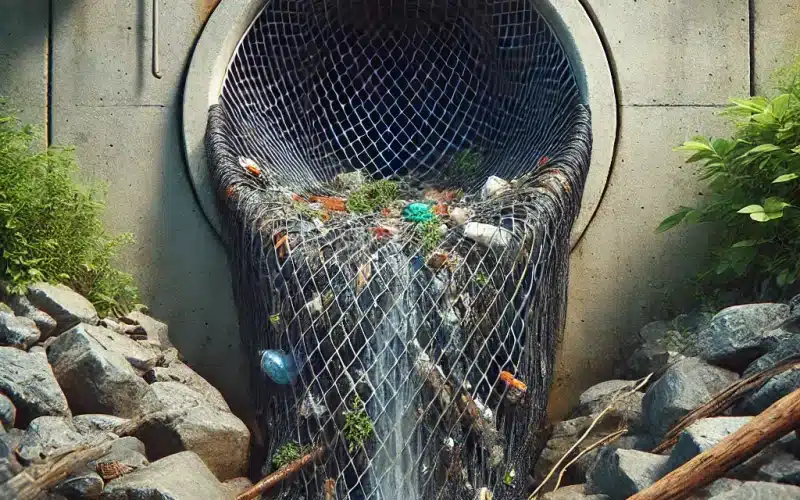
Mesh drains, or drain socks, are a practical and widely used solution in stormwater management, especially in urban settings where pollutants from roads, parking lots, and industrial sites need filtering before reaching natural water bodies.
In this article we will cover what mesh drains are, how they function, their advantages, but also their disadvantages, where they are most effective, and settings where they may not perform well.
But first look at the video below which shows the technique being used in Australia.
What Are Mesh Drains?
Simple Ideas, Big Impacts 🧵
— Wolf of X (@tradingMaxiSL) November 3, 2024
1. Mesh drains in Australia prevent water bodies pollution. Should be a worldwide standard. pic.twitter.com/q2yejG3NED
Mesh drains, also known as sediment control or stormwater mesh drains, or drain socks, are drainage systems designed to capture and filter pollutants from stormwater runoff. Typically installed in urban, commercial, and industrial areas, they help reduce the flow of sediment, litter, and some pollutants into local water bodies.
Mesh drains consist of a permeable material—often metal or durable plastic—placed over a drain, allowing water to pass through while trapping larger debris and particles. They are a front-line defense in urban water management systems.
How Do Mesh Drains Work?
Mesh drains filter stormwater by trapping debris, sediment, and larger particles in the mesh while allowing water to pass through. Here’s a breakdown of their operation:
- Runoff Collection: During rainfall, stormwater flows over surfaces like roads and sidewalks, picking up pollutants, debris, and organic matter. This runoff flows towards mesh drains placed strategically along curbs, streets, and parking lots.
- Filtration: As the runoff reaches the mesh, large pollutants such as leaves, litter, and coarse sediment are captured by the mesh. The mesh’s porosity is designed to allow water through while blocking larger particles.
- Overflow Protection: Mesh drains often include overflow designs to prevent flooding during high-flow events. When excessive water builds up, the system allows some water to bypass the mesh, preventing backups but potentially releasing some pollutants.
- Regular Maintenance: Mesh drains require regular cleaning to remove accumulated debris and maintain filtration efficiency. Without maintenance, drains clog and lose effectiveness, leading to water backflow or overflow.
Pros and Cons of Mesh Drains
Pros
- Effective First-Line Pollution Control: Mesh drains capture a significant amount of sediment, litter, and other large debris, preventing pollutants from entering water bodies.
- Versatile Applications: They are versatile and can be installed in a variety of settings, from urban streets and parking lots to industrial sites and residential areas.
- Cost-Effective Solution: Compared to advanced filtration systems, mesh drains are relatively affordable and easy to install, making them a popular choice for municipalities and developers.
- Supports Green Infrastructure: Mesh drains work well with other green infrastructure (e.g., rain gardens, bioswales) by capturing pollutants at the surface and reducing the burden on more advanced filtration or infiltration systems.
Cons
- High Maintenance Needs: Without frequent cleaning, mesh drains clog with debris, leading to reduced effectiveness. High-maintenance requirements make them less practical in areas without regular upkeep.
- Limited Filtration for Dissolved Pollutants: Mesh drains are less effective at capturing dissolved pollutants like chemicals, oils, and nutrients, which require advanced filtration to remove from runoff.
- Susceptible to Weather Impacts: In areas with heavy rainfall or dry, windy conditions, mesh drains may either overflow or accumulate too much debris, limiting their effectiveness.
- Durability Issues: Some mesh materials degrade over time, especially in extreme climates, leading to potential release of microplastics or other contaminants. Regular replacement or upgrades may be needed in high-impact settings.
Where Mesh Drains Should Be Used
Ideal Locations for Mesh Drains
- Urban Roads and Parking Lots
- Example: A busy downtown street lined with shops and restaurants can generate substantial pedestrian and vehicle-related debris. Installing mesh drains along curbs can capture litter, sediment, and pollutants from vehicles, reducing pollution load in stormwater.
- Industrial and Commercial Sites
- Example: An industrial facility producing machinery parts may generate sediment, metal shavings, and oils. Mesh drains can be placed in high-traffic areas to capture larger contaminants before stormwater enters more extensive treatment systems.
- Residential Areas
- Example: Mesh drains installed along neighborhood streets can catch leaves and organic matter from landscaping, helping prevent clogged drains and reducing the pollutant load in nearby streams.
- Public Parks and Recreational Areas
- Example: Parks with high foot traffic near playgrounds or sports fields benefit from mesh drains that capture litter and sediment, preserving water quality in ponds, rivers, or lakes nearby.
- Waterfront and Riparian Zones
- Example: Mesh drains near marinas or waterfront promenades capture pollutants from boats or even houseboats and public use, reducing the risk of contaminant flow into lakes, rivers, or oceans.
Where Mesh Drains Should Not Be Used
While mesh drains are effective in many scenarios, there are settings where they don’t perform well or may require additional infrastructure to achieve desired outcomes.
Less Effective Locations
- High-Sediment Areas (Construction Sites)
- Example: On construction sites with exposed soil, large volumes of fine sediment quickly clog mesh drains. In these environments, mesh drains need to be paired with sediment basins or other erosion control methods for effective filtration.
- Areas with High Dissolved Pollutants
- Example: In urban zones with frequent vehicle traffic, like near gas stations, runoff often contains oils and dissolved pollutants that mesh drains cannot filter. Here, oil-water separators or advanced filtration systems are necessary for effective water pollution control.
- Regions with Extreme Weather Patterns
- Example: Heavy rain zones, like certain coastal cities, can overwhelm mesh drains. High flow rates wash away trapped pollutants, reducing their effectiveness. Regions prone to long dry spells face clogged drains from accumulated dust and debris.
- Cold Climates with Freezing Conditions
- Example: In sub-freezing regions, water in the mesh can freeze, blocking flow and potentially damaging the mesh structure. Alternative drainage solutions like heated or specialized filters work better in these conditions.
- Remote or Difficult-to-Maintain Locations
- Example: Remote infrastructure, such as highways through sparsely populated areas, are challenging to maintain regularly. Mesh drains in these locations quickly lose functionality without frequent cleaning, making them impractical.
Examples of Complementary Solutions for Mesh Drains
For settings where mesh drains face limitations, combining them with other stormwater management solutions can maximize effectiveness. Here are some examples:
- Oil-Water Separators: In industrial areas, oil-water separators capture oil and grease that mesh drains cannot filter, protecting nearby waterways from chemical contamination.
- Sedimentation Ponds or Basins: At construction sites, sedimentation ponds catch fine particles before water flows to mesh drains, which prevents rapid clogging.
- Bioswales and Rain Gardens: By capturing and infiltrating runoff, these green infrastructure elements reduce the load on mesh drains and help filter pollutants in a natural, sustainable way.
A Practical, Cost-Effective Solution
Mesh drains are a practical, cost-effective solution for managing stormwater pollution in a wide range of urban, industrial, and residential settings. While they capture sediment, litter, and larger particles effectively, they are less suited for environments with high dissolved pollutants, extreme weather patterns, or minimal maintenance access.
While the system has its limitations, planners can use mesh drains strategically, often in combination with other stormwater systems, to protect water quality and enhance urban resilience. Regular maintenance and location-specific adjustments ensure that mesh drains perform optimally and contribute to a healthier environment.
